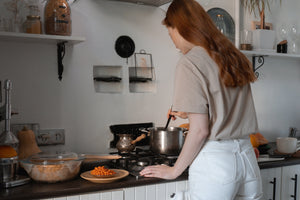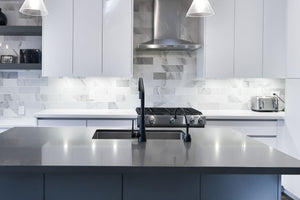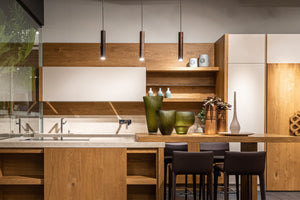The 8 Most Common Types of Kitchen Cabinet Materials and How to Care for Them
Looking for new cabinets for your kitchen? One of the most important choices you’ll make is the type of material. The material your cabinets are made of will influence the durability, appearance, and type of maintenance required. There are several types of cabinet materials available on the market; to help you select the right one, let’s explore the eight most common types, their pros and cons, and their care requirements.
8 Common Types of Kitchen Cabinet Materials:

1. Hardwood

Hardwood is one of the most popular cabinet materials for its traditional appearance and durability.
Made Of: Oak, maple, cherry, and hickory as single, unbroken pieces of natural wood.
Pros: Hardwood cabinets are durable, long-lasting, and can withstand heavy use. They offer natural beauty and a wide range of stains and finishes. Hardwood is also a non-toxic material.
Cons: They're expensive compared to other materials, and they may warp over time in humid conditions.
Care Requirements: Regular dusting and occasional polishing with a gentle, wood-friendly cleaner will keep hardwood cabinets looking their best.
2. Wood Veneer

Wood veneer cabinets are more affordable than solid wood but offer a similar appearance to hardwood; found in a variety of finishes and styles.
Made Of: A thin slice of hardwood bonded to a less expensive material, often plywood or particle board.
Pros: They're less expensive than solid hardwood and lighter, reducing the strain on hinges.
Cons: They can chip or peel over time and don't tolerate heavy wear and tear as well as solid wood.
Care Requirements: Just like hardwood, regular dusting and gentle cleaning with a wood-friendly cleaner can help keep these cabinets in tip-top shape.
3. Plywood

Plywood cabinets are a budget-friendly option for cabinets and are resistant to dents as well as scratches.
Made Of: Thin layers of wood, or plies, glued together under heat and pressure.
Pros: Plywood cabinets are strong and resilient, with better water resistance than many other materials.
Cons: They aren’t quite as durable as hardwood and sometimes come with a veneer finish, which can peel or chip over time.
Care Requirements: Wiping with a damp cloth and a mild detergent will keep plywood cabinets clean. Avoid soaking the cabinets; excessive water can cause damage.
4. Thermofoil

Thermofoil cabinets are popular for their sleek, modern appearance and ability to stand up against water spills and scratches.
Made Of: A vinyl laminate that's heated and molded over medium-density fiberboard (MDF) or engineered wood.
Pros: Thermofoil cabinets are inexpensive, easy to clean, and come in a variety of colors and finishes.
Cons: They are susceptible to heat damage and can be difficult to repair if they get chipped.
Care Requirements: Thermofoil cabinets can be cleaned with a mild detergent and water. Avoid using abrasive cleaners or pads, which can scratch the surface.
5. Laminate

Laminate cabinets are a popular choice for budget-conscious homeowners and those who are looking for durability.
Made Of: Laminate is a synthetic material made of layers of paper and plastic resin fused together under high pressure.
Pros: Laminate cabinets are inexpensive, durable, and available in a wide variety of colors and finishes.
Cons: They're not as durable as wood or plywood cabinets, and once damaged, they can't be repaired.
Care Requirements: Laminate cabinets can be cleaned with mild soap and water. Avoid using abrasive cleaners, which can damage the finish.
6. Particleboard

Like laminate, particleboard is an economical choice for cabinets.
Made Of: Wood chips, sawdust, and resin bonded together under pressure.
Pros: Particleboard cabinets are lightweight and inexpensive.
Cons: They are less durable than other materials and susceptible to water damage (so they’re probably not a top choice for your outdoor kitchen).
7. MDF (Medium Density Fiberboard)

MDF cabinets provide a smooth surface perfect for painted finishes.
Made Of: MDF is an engineered wood product made by breaking down hardwood or softwood residuals into wood fibers and combining it with wax and a resin binder.
Pros: MDF cabinets are dense, strong, and resist warping. They provide a smooth surface, ideal for painting.
Cons: MDF is heavy and can be damaged by water if not properly sealed.
Care Requirements: MDF cabinets can be cleaned with a mild detergent and water. Avoid soaking the cabinets, as water can cause swelling and damage.
8. Melamine

Melamine cabinets are known for their durability and resistance to moisture.
Made Of: A plastic material made from a combination of melamine resin and strengthening materials. It's usually bonded to particleboard or MDF.
Pros: Melamine cabinets are durable, resistant to moisture, and available in a wide range of colors and finishes.
Cons: The core can swell if the melamine coating is chipped and exposed to water. They're also more difficult to install due to their weight.
Care Requirements: Wipe melamine cabinets with a damp cloth and mild detergent. Avoid harsh cleaning products, which can damage the surface.
Additional Resources:
Now that you know the pros and cons as well as care requirements of each popular cabinet material, you’ll be better prepared to choose the perfect one for your taste, budget, and preferences!
To find a range hood designed to fit perfectly under kitchen cabinets, check out our line of under cabinet range hoods. If you're also looking for inspiration for your countertops, we’ve got you covered with our guide to the top 10 countertop materials.
Under Cabinet Range Hoods
From Hauslane








